2013 Peugeot 508 RXH checks
[x] Cancel search: checksPage 5 of 308

.
.
Contents
Child seats 162
ISOFIX child seats 168
Child lock 171
Child safety
Direction indicators 172
Emergency or assistance call 173
Horn 173
ESC system 174
Seat belts 177
Airbags 180
Safety
Te m p o r a ry puncture
repair kit 184
Changing a wheel 190
Snow chains 195
Changing a bulb 196
Changing a fuse 203
12 V battery 207
Energy economy mode 210
Changing a wiper blade 211
Recovering the vehicle 212
Vehicle recovery 214
Towing a trailer 215
Fitting roof bars 217
Very cold climate screen 217
Accessories 218
Practical information
Opening the bonnet 221
Running out of fuel (Diesel) 222
Diesel engine 223
Checking levels 224
Checks 227
Checks
Electric motor 230
Diesel engine 231
Diesel weights 232
Dimensions 233
Identifi cation markings 234
Technical data
Emergency or assistance 235
JBL equipment 237
Peugeot Connect Navigation (RT6) 239
Audio equipment and telematics
Alphabetical index
Visual search
Page 7 of 308

.
5
Familiarisation
For economical driving, caring for the environment
The fuel consumptionof a vehicle varies greatly:
- according to the driver's style of driving
(moderate, aggressive, fast, ...),
- according to the type of journeys
made (urban, main road, motorway, flowing, heavy traffic, …) and the speed.
Main recommendations for driving economically
Hybrid mode selector
To optimise fuel consumption, use the Automodeof the selector whenever possible (the mode is activated
automatically when starting) including for urban journeys.
This mode optimises the use of the energy sources (internal combustion engine and/or electric) contrary to other modes, which are for use in par ticular cases.
Gear lever
Use the automatic
mode A
as much as possible as this optimises gear changes to suit the requirements.
Drive smoothly
Stay in the "eco" zone
displayed in the energy consumption / generation indicator: accelerate gently, drive atsteady speeds using the speed limiter or cruise control as soon as possible. Use the "charge" zone: anticipate the need to slow down by taking your foot off the accelerator rather than
braking. The movement of the energy consumption / generation indicator needle (into the "charge" zone), shows
the level of energy recovery.
Consumption history
See the impact of your style of driving and the type of journey by reviewing the history of your energyconsumption. Refer to the "Multifunction screens" section.
Causes of high consumption and checks
As with any vehicle, limit overloading, wind resistance (windows open above 30 mph (50 km/h), roof rack, loaded
or not, …), the use of power consumers (air conditioning, heated seats, heated rear screen, …).
Obser ve the recommendations on checks (regular check of tyre pressures, correct tyre pressures, …) and routine servicing.
Page 67 of 308
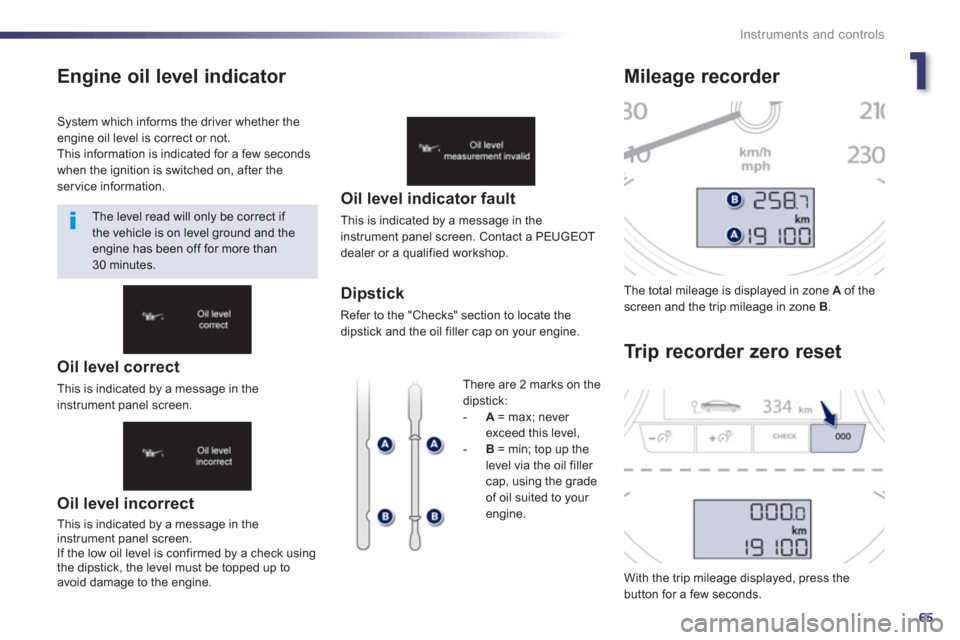
1
65
Instruments and controls
Engine oil level indicator
Oil level incorrect
This is indicated by a message in the
instrument panel screen.
If the low oil level is confirmed b
y a check usingthe dipstick, the level must be topped up to
avoid damage to the engine.
Oil level indicator fault
This is indicated by a message in the instrument panel screen. Contact a PEUGEOT
dealer or a qualified workshop.
Dipstick
Refer to the "Checks" section to locate the
dipstick and the oil filler cap on your engine. The total milea
ge is displayed in zone Aof thescreen and the trip mileage in zone B.
With the trip mileage displayed, press the button for a few seconds.
Mileage recorder
Tr i
p recorder zero reset
System which informs the driver whether theengine oil level is correct or not.
This information is indicated for a few secondswhen the ignition is switched on, after theservice information.
The level read will only be correct if
the vehicle is on level ground and the engine has been off for more than30 minutes.
Th
ere are 2 marks on thedipstick:-A = max; never
exceed this level, -B = min; top up the level via the oil filler cap, using the grade
of oil suited to your
engine.
Oil level correct
This is indicated by a message in theinstrument panel screen.
Page 82 of 308
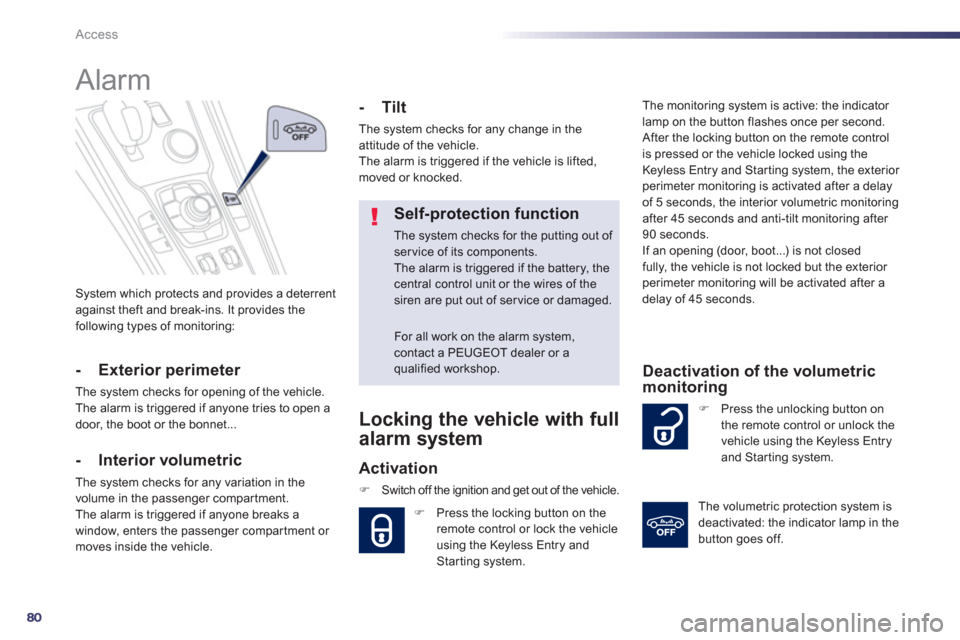
80
Access
System which protects and provides a deterrentagainst theft and break-ins. It provides the
following types of monitoring:
Alarm
- Exterior perimeter
The system checks for opening of the vehicle.
The alarm is triggered if anyone tries to open a
door, the boot or the bonnet...
- Interior volumetric
The system checks for any variation in the
volume in the passenger compartment.
The alarm is triggered if anyone breaks a
window, enters the passenger compar tment or moves inside the vehicle.
- Tilt
The system checks for any change in the attitude of the vehicle.
The alarm is triggered if the vehicle is lifted,
moved or knocked.
Self-protection function
The system checks for the putting out of ser vice of its components. The alarm is triggered if the battery, the central control unit or the wires of the siren are put out of service or damaged.
For all work on the alarm system,contact a PEUGEOT dealer or aqualified workshop.
Locking the vehicle with full
alarm system
Activation
�)Switch off the ignition and get out of the vehicle.
�)
Press the locking button on theremote control or lock the vehicle
using the Keyless Entry and Starting system. The monitorin
g system is active: the indicator
lamp on the button flashes once per second.
After the locking button on the remote controlis pressed or the vehicle locked using the
Ke
yless Entry and Starting system, the exterior perimeter monitoring is activated after a delay
of 5 seconds, the interior volumetric monitoring
after 45 seconds and anti-tilt monitoring after 90 seconds.
If an opening (door, boot...) is not closed
fully, the vehicle is not locked but the exterior perimeter monitoring will be activated after a
delay of 45 seconds.
�) Press the unlocking button on
the remote control or unlock the
vehicle using the Keyless Entryand Star ting system.
Deactivation of the volumetric monitoring
The volumetric protection system is
deactivated: the indicator lamp in the
button
goes off.
Page 113 of 308

3
111
Comfort
In order for these systems to be fully effective, follow the operation and maintenance guidelines below: �)
If the interior temperature remains very high after the vehicle has been parked in the sunfor a considerable time, first ventilate the passenger compar tment for a few minutes. Place the air flow control at a sufficient level to provide an adequate renewal of air in the passenger compartment.�)
To obtain an even air distribution, take care not to obstruct the exterior air intake grilles located at the base of the windscreen, the nozzles, the vents and the air outlets, as wellas the air extractor located in the boot. �)
Use in preference the intake of exterior air as prolonged use of the air recirculation maycause misting of the windows and side windows.�)
Do not cover the sunshine sensor, located on the dashboard; this is used for regulation of the automatic air conditioning system.�)
Operate the air conditioning system for 5 to 10 minutes, once or twice a month to keep itin good working order. �)
Ensure that the passenger compar tment filter is in good condition and have the filter elements replaced regularly (refer to the "Checks" section). We recommend the use of a combined passenger compar tment filter. Thanks to its second special active filter, it contributes to the purification of the air breathed by the occupants and the cleanliness of the passenger compartment (reduction of allergic symptoms, bad odours and greasy deposits).�)
The air conditioning uses power from the engine while operating. This results in anincrease in the vehicle's fuel consumption. When towing at or near maximum capacity or on steep slopes in high ambient temperatures, switching off the air conditioning saves engine power and so improvestowing capacity. Condensation created by the air conditioning results in a discharge of water under thevehicle when stationary, which is per fectly normal.�)
To ensure correct operation of the air conditioning system, you are also advised to haveit checked regularly.�)
If the system does not produce cold air, do not use it and contact a PEUGEOT dealer or a qualified workshop.
Recommendations for ventilation and air conditioning
The air conditioning system does notcontain chlorine and does not present any danger to the ozone layer.
Page 177 of 308
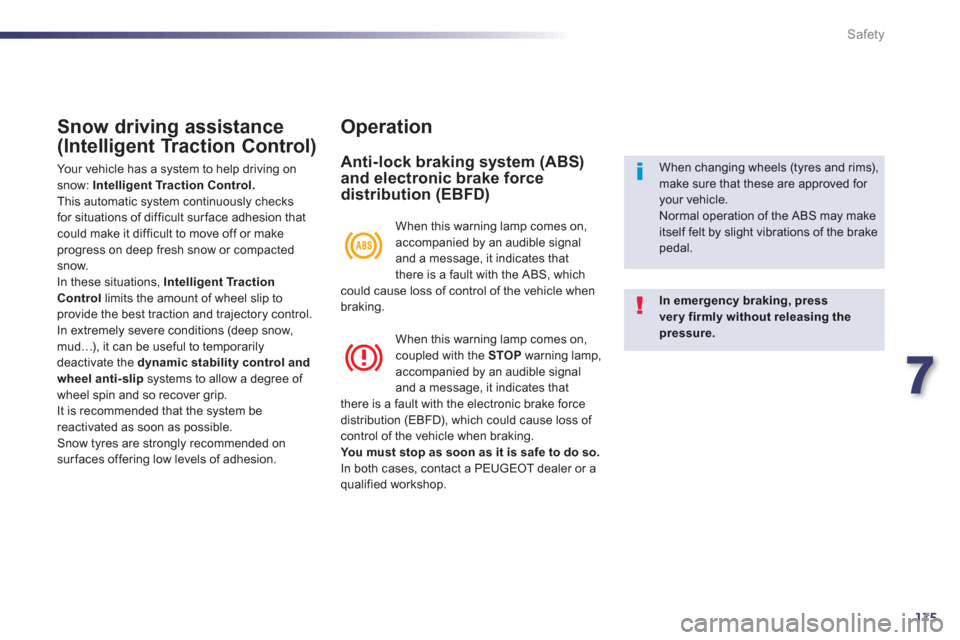
7
175
Safety
Snow driving assistance
(Intelligent Traction Control)
Your vehicle has a system to help driving on snow: Intelligent Traction Control. This automatic system continuously checks for situations of difficult surface adhesion thatcould make it difficult to move off or makeprogress on deep fresh snow or compacted snow.
In these situations, Intelligent Traction
Controllimits the amount of wheel slip to provide the best traction and trajectory control.
In extremely severe conditions (deep snow,mud…), it can be useful to temporarilydeactivate the dynamic stability control andwheel anti-slip
systems to allow a degree of
wheel spin and so recover grip.
It is recommended that the system be
reactivated as soon as possible.
Snow t
yres are strongly recommended on sur faces offering low levels of adhesion.
Operation
Anti-lock braking system (ABS)and electronic brake force
distribution (EBFD)
In emergency braking, press very firmly without releasing the pressure.
When changing wheels (tyres and rims),make sure that these are approved for your vehicle.
Normal operation of the ABS may makeitself felt by slight vibrations of the brake pedal. When this warnin
g lamp comes on,
accompanied by an audible signal
and a message, it indicates that
there is a fault with the ABS, which could cause loss of control of the vehicle whenbraking.
When this warnin
g lamp comes on,coupled with the STOPwarning lamp,
accompanied by an audible signaland a message, it indicates that
there is a fault with the electronic brake forcedistribution (EBFD), which could cause loss of control of the vehicle when braking.
You must stop as soon as it is safe to do so.In both cases, contact a PEUGEOT dealer or a qualified workshop.
Page 222 of 308
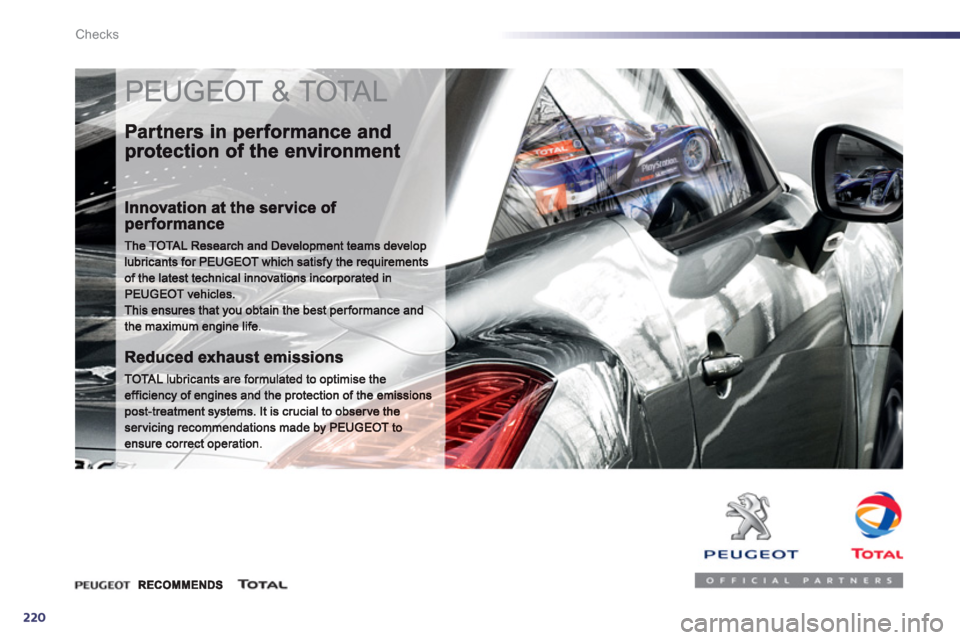
220
Checks
PEUGEOT & TOTAL
Page 223 of 308
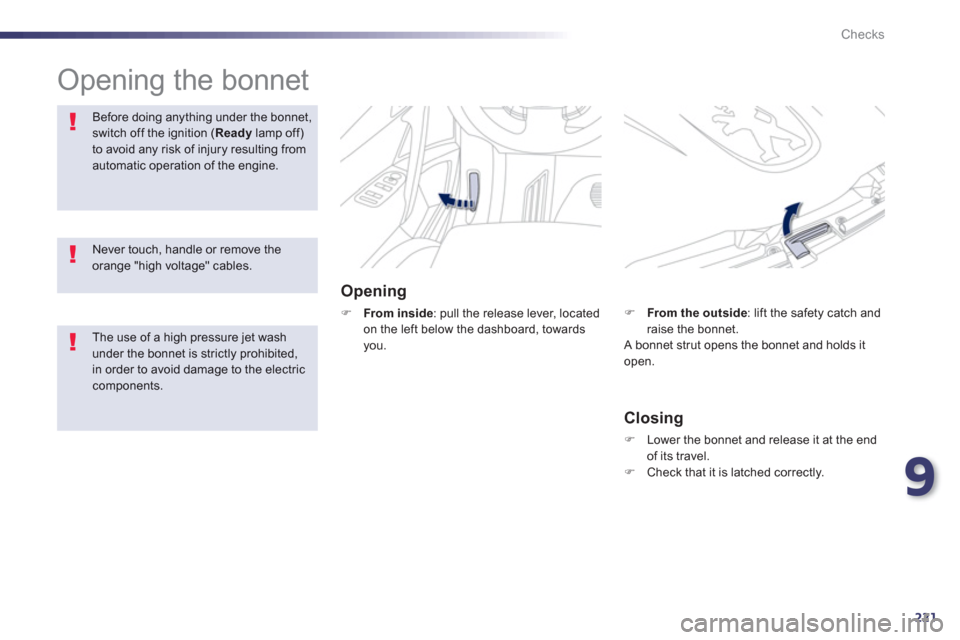
9
221
Checks
Opening the bonnet
Opening
�)From inside
: pull the release lever, locatedon the left below the dashboard, towards you.
Before doing anything under the bonnet,switch off the ignition (Ready
lamp off) to avoid any risk of injury resulting fromautomatic operation of the engine.
Closing
�)
Lower the bonnet and release it at the endof its travel. �)
Check that it is latched correctly.
�)From the outside: lift the safety catch and
raise the bonnet.
A bonnet strut opens the bonnet and holds itopen.
Never touch, handle or remove the orange "high voltage" cables.
The use of a high pressure jet wash under the bonnet is strictly prohibited,in order to avoid damage to the electriccomponents.